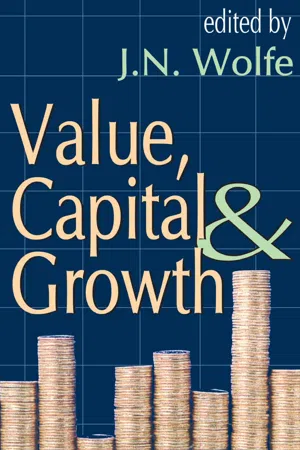
- 563 pages
- English
- ePUB (mobile friendly)
- Available on iOS & Android
Value, Capital and Growth
About This Book
Value, Capital and Growth was written as a mark of honor to Sir John Hicks on the occasion of his retirement as Drummond Professor of Political Economy at the University of Oxford. As the title implies, most of the essays are directed to the development of the three great topics of modern economic theory to which he contributed--Value, Capital, and Growth. More specifically, there are important papers on general equilibrium, aggregation, and index numbers-- all topics of deep interest in international economics.The volume is particularly noteworthy for a number of papers exploring hitherto unrealized implications of general equilibrium models. There are also several papers dealing with mathematical economics as they relate to trade and development, which will be of great interest to students of those fields. Few theorists possessed Hicks catholicity in economics and his interest in and appetite for all branches of applied economics, and especially comparative economic history. His interests ranged from Italian Renaissance banking to academic publishing and the export and import of scholarly works, The international eminence of the contributors and the quality of their work ensure that this volume is a fitting tribute to a great economist and that it will be studied carefully for many years. No effort was spared to present the work in a style and format worthy of the subject and of the occasion. The volume includes masterful contributions by Kenneth Arrow, Jagdish Bhagwati, Roy Harrod, Paul A. Samuelson, Robert M. Solow, and Alan A. Walters among others, and contains a full biographical and bibliographical data base on Hicks.J.N. Wolfe was professor of economics at the University of Edinburgh until his retirement.
Frequently asked questions
Information
1
Optimal Capital Policy with Irreversible Investment
Introduction
Table of contents
- Cover Page
- Title Page
- Copyright
- Contents
- Introduction by J.N. Wolfe
- 1 Optimal Capital Policy with Irreversible Investment
- 2 Trade Liberalization among LDCs, Trade Theory, and Gatt Rules
- 3 Income, Wealth, and the Theory of Consumption
- 4 Taste and Quality Change in the Pure Theory of the True Cost-of-Living Index
- 5 Measuring the Quantities of Fixed Factors
- 6 What is a Model?
- 7 Normal Backwardation
- 8 Wicksell on the Facts: Prices and Interest Rates, 1844 to 1914
- 9 A Partial Theoretical Solution of the Problems of the Incidence of Import Duties
- 10 Time, Interest, and the Production Function
- 11 The Principle of Two-stage Maximization in Price Theory
- 12 Two Classical Monetary Models
- 13 Information and Period Analysis in Economic Decisions
- 14 On Hicksian Stability
- 15 Accumulation Programs of Maximum Utility and the von Neumann Facet
- 16 Free Trade and Development Economics
- 17 An Economic Test of Sir John Hicks’s Theory of Biased Induced Inventions
- 18 Hicksian Stability, Currency Markets, and the Theory of Economic Policy
- 19 Two Generalizations of the Elasticity of Substitution
- 20 Short-run Adjustment of Employment to Output
- 21 Time Preference, the Consumption Function, and Optimum Asset Holdings
- 22 The Demand for Money Expectations and Short and Long Rates
- Sir John Hicks: Biographical and Bibliographical Data
- List of Works Referred to